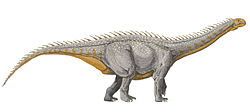| Tataouinea | |
|---|---|
 | |
| Reconstructed skeleton (with unknown elements based on Nigersaurus ), with known elements in pink | |
| Scientific classification | |
| Kingdom: | Animalia |
| Phylum: | Chordata |
| Class: | Reptilia |
| Clade: | Dinosauria |
| Clade: | Saurischia |
| Clade: | † Sauropodomorpha |
| Clade: | † Sauropoda |
| Superfamily: | † Diplodocoidea |
| Family: | † Rebbachisauridae |
| Genus: | † Tataouinea Fanti et al., 2013 |
| Species: | †T. hannibalis |
| Binomial name | |
| †Tataouinea hannibalis Fanti et al., 2013 | |
Tataouinea is an extinct genus of sauropod dinosaur in the subfamily Rebbachisaurinae of Rebbachisauridae which lived in the Early Cretaceous of Tunisia. Only one species, T. hannibalis, is known. [2]













